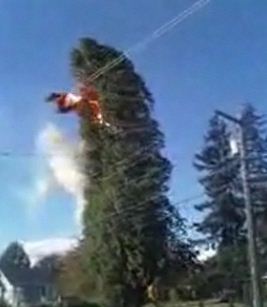A team of cause and origin fire investigators led by New Mexico State Forestry has determined that a powerline caused the Las Conchas fire northwest of Santa Fe, New Mexico. The fire has become the largest fire in New Mexico history and has blackened over 121,000 acres while running up suppression costs of $5.4 million and burning 63 residences. Here is an excerpt of a news release at New Mexico Fire Information:
An interagency investigative team led by New Mexico State Forestry has been determined that the Las Conchas Fire was caused by a fallen tree that caught fire after coming into contact with nearby power lines, according to New Mexico State Forester Tony Delfin.
Investigators from New Mexico State Forestry, the USDA Forest Service, New Mexico State Police and Sandoval County conducted the investigation and were on scene shortly after the fire started on Sunday, June 26. Since then, the fire has burned more than 121,248 acres.
Investigators believe the fire started after an aspen tree was blown down onto nearby power lines during a period of strong winds. The contact resulted in the line arcing, which then caused the tree to catch fire. Heat and flame caused the line to snap, which then allowed the burning tree to fall onto the ground where the fire spread into nearby vegetation.
We found a video of a fire starting when a tree contacted a powerline in Bellingham, Washington. Below is a screen capture, and HERE is a link to the video.


